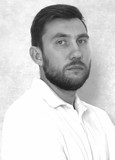Physiological mechanisms determining the performance of passing control standards for physical culture
Keywords:
psychophysiological characteristics, cluster analysis, artificial neural networks.Abstract
Abstract
Objective of the study was to identify significant physiological mechanisms of performance formation when passing control standards in physical culture and to establish the relationship between performance indicators and individual psychophysiological characteristics.
Methods and structure of the study. 120 young men aged 18-20 years old belonging to the main health group were examined. With the help of cluster analysis, groups were identified with different performance in passing control standards in terms of speed endurance and speed-strength indicators. To solve the problem of classifying students, taking into account their psychophysiological characteristics, an artificial neural network (ANN) was created, distributing students into groups with specified characteristics.
Results and conclusions. When analyzing the motivational basis of behavior, it was revealed that the students of the first cluster were dominated by an internal motive and the motive of focusing on success, with at the same time high rates of assessing their potential. The students of the second cluster were dominated by the motive for assessing the significance of the result of activity. Statistically significant differences in personal psychophysiological characteristics and indicators of physical performance were established in the subjects of the identified clusters. On the basis of a set of data obtained, cluster analysis and ANN technology made it possible to predict the performance of students with a high probability, as well as to rank indicators according to their significance for the formation of unequal performance.
References
Bragina N.N., Dobrokhotova T.A. Funktsionalnyye asimmetrii cheloveka [Functional human asymmetries]. 2nd ed., rev., add.. Moscow: Meditsina publ., 1988. 240 p.
Danilova N.N., Krylova A.L. Fiziologiya vysshey nervnoy deyatelnosti [Physiology of higher nervous activity]. Rostov-on-Don: Feniks publ., 2005. 478 p.
Zorin R.A., Zhadnov V.A., Lapkin M.M. Opyt prakticheskogo ispolzovaniya tekhnologii iskusstvennykh neyronnykh setey v fiziologii i klinicheskoy nevrologii [Experience in the practical use of artificial neural networks technology in physiology and clinical neurology]. Proceedings national scientific conference, dedicated 70th anniversary of the founding of the I.P. Pavlov Ryazan State Medical University. Ryazan, 2013. pp. 25-28.
Lapkin M.M., Yakovleva N.V., Proshlyakov V.D. Issledovaniye psikhologicheskikh i fiziologicheskikh determinant uspeshnosti obucheniya studentov v meditsinskom vuze [Study of the psychological and physiological determinants of student learning success in a medical university]. Lichnost v menyayushchemsya mire: zdorovye, adaptatsiya, razvitiye. 2014. Vol. 4. No. 1. pp. 75-83.
Novikova A.P., Kotov A.V. Motivatsiya dostizheniya: psikhofiziologicheskiye korrelyaty i ikh dinamika v khode dlitelnogo obucheniya [Achievement motivation: psychophysiological correlates and their dynamics during long-term training]. Neyrokompyutery: razrabotka, primeneniye. 2011. No. 11. pp. 46-52.
Proshlyakov V.D. Otsenka fizicheskogo razvitiya i metodika trenirovki studentov [Assessment of physical development and methods of training students]. Guidelines for students. Ryazan: RyazGMU publ., 2007. 43 p.
Psikhofiziologiya [Psychophysiology]. Textbook for universities. Alexandrova Yu.I. [ed.]. St. Petersburg: Piter publ., 2007. 464 p.
Boev V.M., Borshchuk E.L., Ekimov A.K. et al. Rukovodstvo po obespecheniyu resheniya mediko-biologicheskikh zadach s primeneniyem programmy Statistica 10.0 [Guidelines for ensuring the solution of biomedical problems using the Statistica 10.0 program]. Orenburg: Yuzhnyy Ural publ., 2004. 208 p.
Saltykov A.B. Funktsionalnyye sistemy v meditsine [Functional systems in medicine]. Moscow: Meditsinskoye informatsionnoye agentstvo publ., 2013. 208 p.
Sudakov K.V. Motivatsiya i podkrepleniye: sistemnyye neyrofiziologicheskiye mekhanizmy [Motivation and reinforcement: systemic neurophysiological mechanisms]. Vestnik Novgorodskogo GU, 2006. No. 35. pp. 77-81.
Sudakov K.V., Umryukhin P.E. Sistemnyye mekhanizmy emotsionalnogo stressa [Systemic mechanisms of emotional stress]. Moscow: GEOTAR-Media publ., 2010. 112 p.
Fudin N.A., Vagin Yu.E. Sistemnaya organizatsiya sportivnoy deyatelnosti [Systematic organization of sports activities]. Vestnik novykh meditsinskikh tekhnologiy (elektronnyy zhurnal). 2013. No. 1 (2-82). pp. 1-5.
Brooks G.A., Fahey T.D., Baldwin К.M. Exercise physiology: human bioenergetics and its applications. NY: McGraw-Hill, 2005. 511 p.
Moein S. Medical diagnosis using artifi cial neural networks. Hershey: Medical Information Science Reference, 2014. 310 p.
Rektor I., Brazdil M., Nestrasil I. [et al.] Modifications of cognitive and motor tasks affect the occurrence of event-related potentials in the human cortex. The European Journal of Neuroscience. 2007. Vol. 26, № 5. pp. 1371-1380.
Parker A.G., Hetrick Sarah E., Anthony F. Jorm The effectiveness of simple psychological and physical activity interventions for high prevalence mental health problems in young people: A factorial randomised controlled trial. Journal of affective disorders. 2016. Vol. 196. pр. 200-209.


